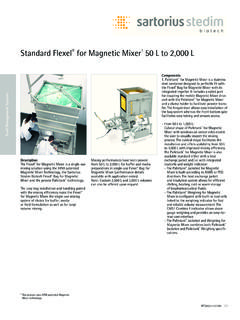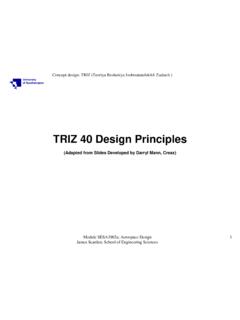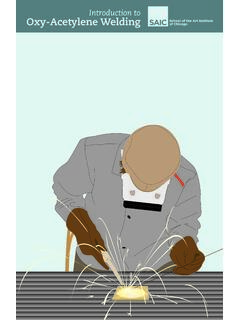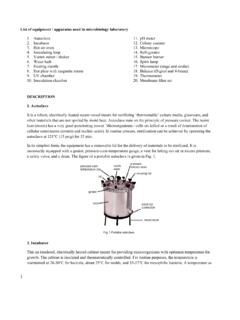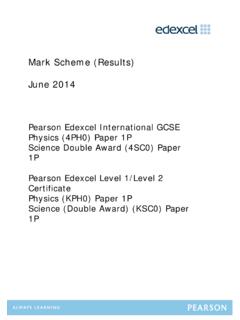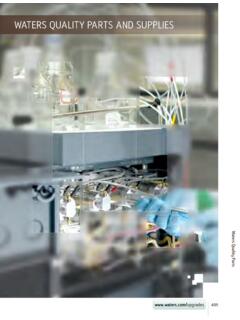Transcription of Phenol-Chloroform Isoamyl alcohol (PCI) DNA extraction and ...
1 Molecular Biotechnology-Theory Lecture 5 4th Grade Medical analysis March 4 /2021 Phenol-Chloroform Isoamylalcohol (PCI) DNA extractionand Ethanol Precipitation. protocol Principle of PCI method:The basic principle of Phenol-Chloroform DNA extraction method is based on the liquid-liquid extraction of biomolecules. The protein portions of the cell are denatured and removed by separating DNA into the soluble phase. The entire mechanism of separation is based on the solubility of the biomolecules. Water is a polar solvent and phenol is a non-polar solvent. Also, phenol is denser than the other hand, DNA is a polar molecule with a net negative charge on its backbone and protein is non-polar. As we all know that the polar molecule can dissolve in polar solutions thus DNA dissolves in water but not in phenol. Practical Molecular Biotechnology MuhsinJamilAbdulwahidLecturer in Molecular GeneticsAdditionally, water can not mix with the phenol so phenol remains at the bottom due to its higher density.
2 Meanwhile, DNA dissolves in water/chloroform and remains on the top of the phenol as a watery layer( aqueous phase). When we mix phenol with the cell suspension the protein portion of the cell get digested or denatured and when we centrifuge it, the denatured protein settled into the bottom of the tube along with the phenol. During the process of mixing, when sample and phenol are mixing together, it forms the foam-like emulsion (emulsification). Role of each chemical:Phenol:Phenol(also called carbolic acid) is an aromatic organic compound with the molecular formula C6H5OH. DNA is insoluble in phenol because phenol is a non-polar solution. On the other side, proteinhas both polar and non-polar group present in it because of the long chain of different amino acids. Different amino acids have different groups present on their side , the folding of the protein into the secondary, tertiary and quaternary structure depends on the polarity of the amino acids.
3 The bonds between amino acids are broken by the addition of phenol and protein get , we can say the protein become unfolded by addition of : Chloroform increases the efficiency of phenol for denaturation of the protein. Here, chloroform allows proper separation of the organic phase and aqueous phase which keeps DNA protected into the aqueous phase. Chloroform denatures the lipid as well. Isoamylalcohol: In the Phenol-Chloroform DNA extraction method, Isoamylalcohol helps in reducing foaming between interphase. It prevents the emulsification of a liquid phase contains DNA and the organic phase contains lipid, proteins and other impurities. The precipitated protein denatured and coagulated between both these phases. This will create the cloudy, whitish-foam between interphase. The anti-foaming agent, isoamylalcohol stabilized the interphase by removing the foaming. This will increase the purity of Role in DNA extraction TrisIt maintains the pH of the solution and also permeabilizes the cell membrane.
4 EDTAIt is a chelating agent and blocks the activity of is an anionic detergent which helps in denaturation of cell membrane protein. NaClPrevents the denaturation of DNA MgCl2 Protects DNA from mixing with other cell organellesTE buffer It dissolves DNADNA extraction from whole blood protocol ml of blood sample is transferred to a centrifuge tube with 12-15 ml Centrifuge the samples at 4000 rpm for 15 minutes at room temperature, to obtain a cellular pellet, and discard the Add 2ml of lyses buffer 2X, then the sample inverting several times and left the mixture at 4 C for 10-30 Centrifuge the mixture at 3000rpm for 10 minutes to obtain a nuclear pellet, and then discard the supernatant. 5. Re-suspended the nuclear pellet in 1ml of salt/EDTA buffer and mixing by using vortexes To re-suspending the pellet, add 100 l of 10% SDS, and 10 l of 20mg/ml ProtinaseK 7. The latter mixture was then incubated at 37 C The optimal temperature for ProtinaseK activity ranges between 50-65 C for 10-30 minutes.
5 The higher temperatures help with protein unfolding, easing the ability for proteinase K to breakdown those Following incubation, 1ml of phenol (saturated with TrisHClpH ) was added, and then mixed on a rotary mixer, for 10 minutes, followed by centrifugation at 2000rpm for 5 minutes (using a bench centrifuge). supernatant was then transferred to another tube, then re-extracted with 1ml chloroform: Isoamylalcohol (24:1), and then mixed on a rotary mixer, for 10 minutes, followed by centrifugation at 2000rpm for 5 The supernatant from the last step was mixed gently with of Ammonium acetate and 3ml of absolute ethanol, to precipitate DNA, and the mixture was cooling at 4 C for 2-4 If the precipitate DNA visualize then removed with a Pasteur pipette whose end has been sealed and shaped into a U and left to dissolve in 200 l of sterile Tris/EDTA buffer on a rotary mixer If the DNA precipitated becomes fragmented and not visualized, collect it by centrifugation at 4000rpm.
6 14. Discard the supernatant and add 200 l of sterile Tris/EDTA buffer and on a rotary mixer overnight to dissolve the DNA. out DNA isolation : explain the DNA replication processPreparation of materials used in phenol chloroform isoamylDNA extraction methodLyses buffer 2X: It was prepared by dissolving g of Ammonium Chloride, and g of Potassium Hydrogen Carbonate in ml of EDTA (pH ). The volume made up to 100ml by distillated water, autoclaved and store at 4 Buffer: It was prepared by dissolving g of Sodium Chloride in of M EDTA (pH ). The volume was made up to 100ml by distilled water, autoclaved and stored at 4 Buffer: was prepared by adding ml of 1M Trisbuffer (pH ), to ml of M EDTA (pH ). The volume was made up to 250 ml by distilled water, autoclaved and stored at 4 pH : was prepared by dissolving g of Trisbase in 400ml of distilled water.
7 Concentrated HClwas added to adjust the pH to volume was made up to 500ml by the distilled water and sterilized by pH : was prepared by dissolving g of Trisbase in 800 ml of distilled water, pH was adjusted to by concentrated HCl. The volume was made up to 100 ml by adding distilled pH : was prepared by dissolving g of EDTA in 400 ml of distilled water and stirred vigorously on a magnetic stirrer. pH was adjusted to using 10N NaOH. The volume was made up to 500ml by distilled water, and sterilized by : Isoamylalcohol (24:1): To prepare 100ml of this mixture, 96ml of chloroform was added to 4ml of Isoamylalcohol and stored in a dark bottle at 4 C until : was prepared by dissolving 40 g of NaOHin 80 ml of distilled water. The volume was made up to 100 ml by distilled : was prepared by melting Crystalline phenol at 68 C water bath, and then overlaid with an equal volume of 1M TrispH , and allowed to stand overnight at 4 1M Triswas then discarded to be replaced by TrispH ( ), stored at 4 C for up to 4 Solution 10%: was prepared by dissolving 100g of SDS in 900ml of distilled water with heating at 68 C to assist dissolution.
8 The volume adjusted to one liter using distilled acetate : was prepared by dissolving g ammonium acetate in 10ml distilled water, sterilized by filtration through m 70%: was prepared by a mixing 70 ml of absolute ethanol and 30ml of distilled water.



